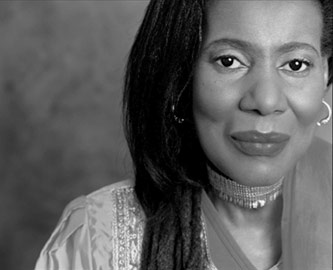American Music Review
Vol. XLI, No. 1, Fall 2011
By Carl Clements, Columbia University
Alice Coltrane is an important, but often overlooked, figure in the history of jazz. Despite her own distinctive contributions, she is best known in jazz circles as the wife of the legendary saxophonist John Coltrane. Nonetheless, she herself was clearly a powerful presence—not only as a jazz and avant-garde musician, but as spiritual and familial partner to one of the greatest musicians in the history of jazz, and later as a respected spiritual leader in her own right. In the introduction to her book Monument Eternal: The Music of Alice Coltrane (Wesleyan University Press, 2010), Franya J. Berkman clearly states that she is not writing a jazz biography, but rather "an exploration of the music of a woman and devotional musician whose contributions transcend such genre-specific constraints" (3). While there is a good deal in this book that should be of value to jazz historians, this is as much a work about a woman's quest to find a non-denominational, multicultural spiritual awareness loosely based on a Hindu religious framework. The totality of her own richly layered identity is thoroughly explored. For the last decade of her life, Alice Coltrane left behind her career as a jazz musician and dedicated herself to her role as spiritual guru. Her musical output in this period consisted primarily of her own idiosyncratic interpretations of the Indian devotional musical form known as bhajan.
Berkman writes from the perspective of an ethnomusicologist rather than a jazz historian. While part of her objective is to demonstrate Alice Coltrane's role in broadening the definition of jazz, she places a strong emphasis on Coltrane's contributions to the infusion of a hybrid spirituality into the music of African American composers and performers in the late twentieth century. The author traces Coltrane's development through the major stages of her musical growth. Chapter One begins with Coltrane's childhood in Detroit where she developed into a skilled and versatile musician through her involvement with the black church and the tutelage of some of the finest young jazz musicians of the time. The narrative continues with Coltrane's relatively brief life in Paris where she further honed her piano skills under the mentorship of the great Bud Powell, her struggles as a musician and single mother in New York and Detroit, and her tenure recording and touring with vibraphonist Terry Gibbs.

Alice Coltrane
Chapter Two deals with Alice Coltrane's years with John Coltrane as wife, mother, spiritual partner, and band member. In 1966, after several years dedicated to rearing her three young sons, she replaced McCoy Tyner as the pianist in her husband's band. Following John Coltrane's death in 1967, Alice Coltrane developed substantially as an avant-garde musician, and is featured on the six albums that the band released during this period. This chapter also delves into her role in the infusion of a universal spirituality into jazz and avant-garde music, initially inspired by and in collaboration with her husband. While this spirituality was in large part derived from Eastern, particularly Indian, religious thought, Berkman draws a connection between it and the expansion of American, and specifically African American, religious thought in the twentieth century.
In the third chapter, Berkman discusses Alice Coltrane's musical and spiritual development following the death of her husband, demonstrating the strong link between her compositional sensibility and her spiritual transfiguration. The author breaks the time span between 1968 and 1978 into three periods: 1968–70, when she carried on John Coltrane's musical legacy; 1970–71 when she met Swami Satchidananda, traveled to India, and began her studies of Indian Vedanta (a philosophy based on ancient Indian scriptures that looks to self-realization as a means of understanding the ultimate nature of reality); and 1971–78, when she formed an independent musical and spiritual identity and began focusing on her bhajan interpretations. While Berkman stresses the uniqueness of Alice Coltrane's approach to music and spirituality, she also emphasizes that earlier African American explorations of Indian ideas of universal consciousness, as well as expanded Indian immigration into the U.S., had paved the way.
The final chapter tells of Alice Coltrane's initiation "from the Lord" (94) as a swamini, or Hindu spiritual teacher, in 1976. During this final period of her life she took on the name Turiyasangitananda and dedicated herself to spiritual teaching at her ashram, where the primary form of worship was the singing (with Coltrane's keyboard accompaniment) of her bhajan interpretations. While these interpretations (some of which are available on recordings) mostly use texts from Indian bhajans, the music was composed by Coltrane. Berkman discusses various eclectic sources, particularly African American gospel music, that permeate the music.
Berkman includes three sections of musical analysis. While not extensive, these are useful in helping to convey the general musical character of Alice Coltrane's style during the different phases of her career. In some cases, the examples do not supply sufficient evidence to fully support the points the author is trying to make, or seem to force the analysis to fit the narrative. Nonetheless, they do demonstrate some of the changes in Coltrane's stylistic development.
Berkman's discussion of Coltrane's Indian inspirations would have been enriched by more focus on the nature of the spiritual beliefs and musical styles as they are practiced in Indian society. Further, the author refers briefly, and seemingly uncritically, to Coltrane's "many creative, yet inauthentic uses of world-music sources," (73) largely failing to address the many questions of Orientalist discourse that would seem to apply here. Nonetheless, the book serves as an insightful ethnomusicological study of personalized cultural appropriation by a highly creative and eclectic African American musician.






